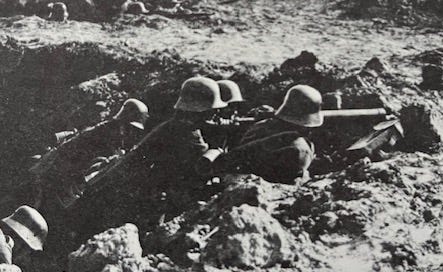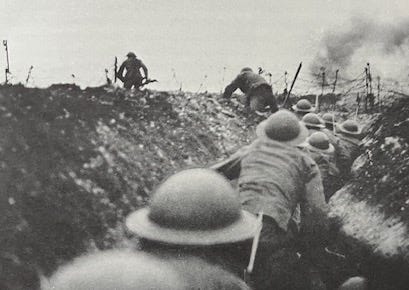1914-18 'the war to end war': the epic tragedy that still haunts Europe
Everything commanders had learned about strategy, operations and tactics rapidly became redundant in a horrorscape of mud, blood, and infernal noise
By DAVID MYTON
In July 1914 my grandfather, Arthur, was a young man with a plan.
Arthur had made some decent money out of his Hansom Cab business, clip-clopping paying passengers through the cobbled streets of the ancient city of York in northern England.
So he decided to buy one of those new-fangled motorcars, imagining that his new, cutting-edge taxi business would keep him and his young family secure for years to come.
But it didn’t. Four years later Arthur, now serving on the Western Front with the British Army’s Royal Artillery, copped a lungful of gas during a German counter-attack.
I can’t help but think of lines from poet Wilfred Owen’s ‘Dulce et Decorum Est’ …
Gas! GAS! Quick, boys! - An ecstasy of fumbling
Fitting the clumsy helmets just in time,
But someone still was yelling out and stumbling
And flound’ring like a man in fire or lime …
Arthur survived, but he never drove a taxi again. He lived the rest of his life as an invalid, surviving close to poverty on whatever benefits he and his family could claim.
He died before I was born. I never got the chance to meet him.
Grief and tragedy
This is just one story from that war, of such little magnitude that it barely registers on the conflict’s Richter Scale of grief and tragedy.
But it’s there all the same, along with millions of others who suffered in one way or another because of that Great War.
Its impact ripples out even today, the various post-war treaties and deals hammered out at Versailles and elsewhere unintentionally setting up the preconditions for much of the world’s current problems.
“The war that will end war” – the phrase is from a 1914 book by HG Wells – kicked off at 8.02am on August 4 1914 when the German army unleashed what they imagined would be a massive Bewegungskrieg (war of manoeuvre).
The plan was for a rapid thrust through Belgium into Northern France, but it ground to a halt after it encountered reality in the form of fierce resistance from French and British forces at the Battle of the Marne.
By mid 1915 it was all stalemate on the Western Front - 764 kilometers of opposing trenches running from the North Sea coast to the Swiss border.
Formidable obstacles, they typically comprised three lines - forward, main, and support trenches all protected by bristling rolls of barbed wire, artillery, and enfilading machine-guns.
Making life extra difficult for the Allies in attack is that the opposing German trenches were situated slightly uphill, often spanning ridge tops that enabled accurate artillery and machine-gun fire.
They could also delve into the chalk substrata beneath their positions to construct relatively shell-proof dugouts up to 10 metres deep.
Mud, blood and infernal noise
World War 1 was unlike any before it in its scale and complexity.
Historian Professor Gary Sheffield says it represented a “clash of 20th century technology with 19th century military science”.
Everything commanders had learned about strategy, operations and tactics rapidly became redundant in a horrorscape of mud, blood, and infernal noise.
Defence dominated the offensive in a grim war of attrition. Advances frequently ended in mass casualties for little or no territorial gain.
Troops from the Australian Imperial Force served on the Western Front from April 1916 and figured in campaigns including the Somme, Fromelles, and Pozieres.
Many had experienced trench warfare already in the ill-fated Gallipoli campaign, which ironically had been launched in part as a response to Winston Churchill’s question: “Are there not other alternatives than sending our armies to chew barbed wire in Flanders?”
The north European battlefields were replete with towns, villages, rivers and woods whose names today simultaneously ring both dolorous and dulcet: Passchendaele, Ypres, Messines, Arras, Thiepval, the Somme.
It was at this last that an epic tragedy was played out from July 1 to November 18 1916 – the Battle of the Somme.
Colossal artillery barrage
It was not British Commander Douglas Haig’s choice to fight there. French General Joseph Joffre demanded the British attack to take the pressure off his troops under siege at Verdun.
A colossal artillery barrage lasting four days involving 445 guns, ranging from trench mortars to 15-inch howitzers, preceded the July 1 British infantry assault.
If you were Haig you might think - “that’ll do it”.
But when the infantry scrambled from the trenches many were mown down before they could fire a shot, leading to 57,470 casualties including 19,240 killed.
Nevertheless, the seeds of a revolution in military affairs were sown in the later phases of the Somme offensive. On September 15 the tank – 36 of them – made its debut.
They were to have a much bigger impact in November 1917 when 381 of the beasts were unleashed to great effect at Cambrai.
The trench deadlock slowly began to crumble amid much bitter fighting.
There is no shortage of opinion and criticism when it comes to that war.
Professor Margaret MacMillan says it is estimated that to date some 32,000 books in English have been published just on the origins of the Great War.
That’s 32,000 opinions, angles, agendas and viewpoints ranging through Pulitzer Prize winner Barbara Tuchman’s The Guns of August to Fritz Fischer’s Germany’s Aims In The First World War.
Lions led by donkeys?
Modern views of Britain’s World War 1 commanders as callous buffoons and dim-witted toffs have in part been shaped by the likes of poets such as Owen, Siegfried Sassoon, Robert Graves, Isaac Rosenberg, and Edmund Blunden.
In 1961 politician and author Alan Clark declared that the British Army had consisted of “lions led by donkeys”.
As Cambridge University’s Professor David Reynolds puts it, the war did not follow a heroic narrative such as that attributed to World War 2 - it appeared to be a subject “either for tragedy or for satire”.
Many of the senior officers in World War 1 were not prepared for the conflict that unfolded. They had to adapt or die, literally.
Historian Professor John Bourne says they didn’t have a script to follow.
“What they were doing was unique … no one had been asked to do it before or again. [It was] like learning to drive by having a series of road crashes.”
References
Ross Beadle, 'The Origins of the Schlieffen Plan', Western Front Association YouTube lecture -
John Bourne, 'The BEF: The Final Verdict', Western Front Association YouTube lecture
Christopher Clark, The Sleepwalkers: How Europe Went to War in 1914, Harper, 2013.
Sir Richard Evans, 'Politics and the First World War' YouTube lecture
B H Liddell Hart, History Of The First World War, Book Club Associates, London, 1970.
John Keegan, The First World War, Hutchinson, London, 1998.
Alan Lloyd, The War In The Trenches, Book Club Associates, London, 1976.
Field-Marshal Viscount Montgomery of Alamein, A History Of Warfare, Collins, London, 1968.
David Reynolds, 'How Our Perception Of WW1 Has Been Moulded Over Time - The Long Shadow', Timeline World History Documentaries – YouTube lecture
David Reynolds, 'The Long Shadow: The Great War and International Memory 1914-2014' YouTube lecture
Gary Sheffield, 'Douglas Haig: Hero of Scotland, Britain and the Empire', Western Front Association, YouTube lecture -
Gary Sheffield, 'The Great War: Its End and Effects', YouTube lecture -
Wilfred Owen, Strange Meeting
Barbara W Tuchman, The Guns of August, Penguin Books, London, 2014.





